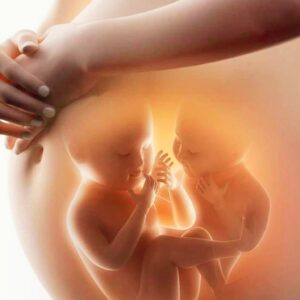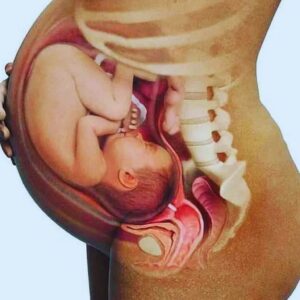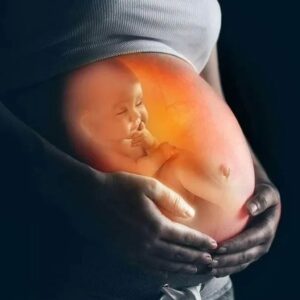In the vast expanse of human experiences, the miracle of pregnancy stands out as one of the most profound and emotionally charged. Among the countless moments that mark this journey, few are as universally cherished and deeply moving as the first signs of life felt from within. For a mother, these miraculous movements of her baby in the womb represent not only a confirmation of life but a tangible connection to the child growing inside her. This article delves into the emotional and physical significance of these moments, capturing the essence of a mother’s delight and happiness.
The First Flutter: A Moment of Realization
The first time a mother feels her baby move is often described as a flutter, a gentle, almost imperceptible sensation that is both magical and bewildering. This moment, known as quickening, typically occurs between the 16th and 25th weeks of pregnancy. For many mothers, it is the first unmistakable sign that there is indeed a new life growing inside them.
Quickening is more than just a physical sensation; it is a moment of profound realization. The abstract concept of pregnancy suddenly becomes real, and the bond between mother and child begins to take shape. This first flutter is often accompanied by a surge of emotions—joy, wonder, and an overwhelming sense of love.

The Emotional Landscape: Joy and Anticipation
As the baby continues to grow, these movements become stronger and more frequent. Each kick, roll, and hiccup is a reminder of the life within and a source of immense joy for the mother. The anticipation of feeling these movements creates a deep emotional connection, fostering a bond that will only grow stronger with time.
Feeling the baby move also provides reassurance. In the quiet moments of the day, when a mother feels her baby stretch or kick, she is comforted by the knowledge that her baby is healthy and active. This connection transcends the physical, touching the very core of a mother’s heart and soul.
Capturing the Moment: The Role of Photography
In today’s digital age, many mothers choose to document their pregnancy journeys through photographs. These images serve as a visual narrative, capturing the excitement and anticipation of bringing a new life into the world. A photograph of a mother gently cradling her belly can convey a thousand words, encapsulating the joy, love, and hope that define this unique period in her life.
Such photographs become cherished keepsakes, preserving the fleeting moments of pregnancy for years to come. They offer a glimpse into the intimate relationship between mother and child, a relationship that begins long before birth and continues to evolve throughout a lifetime.

The Universal Experience: Shared Joy
The experience of feeling a baby move is universal, transcending cultural and geographical boundaries. It is a shared joy, one that connects mothers around the world. This common thread weaves a tapestry of stories, each unique yet strikingly similar in the emotions they evoke.
From the expectant mother in a bustling city to the one in a quiet rural village, the delight of feeling her baby move is a moment of pure, unadulterated happiness. It is a reminder that amidst the vast diversity of human experiences, there are moments of profound connection that unite us all.
The Father’s Perspective: A Shared Journey
While the physical sensations of pregnancy are unique to the mother, the emotional journey is often shared with the father. For many fathers, feeling the baby move for the first time is a transformative experience. It marks a shift from abstract understanding to a tangible connection with their unborn child.
Fathers often describe this moment as a turning point, one that deepens their emotional investment in the pregnancy. It is a moment of realization that they too are part of this miraculous journey, and it fosters a sense of responsibility and anticipation for the arrival of their baby.

The Science Behind the Movements: Understanding Fetal Activity
From a scientific perspective, fetal movements are an indicator of a healthy pregnancy. These movements are the result of the baby’s developing muscles and nervous system. As the pregnancy progresses, the patterns of movement can offer valuable insights into the baby’s well-being.
Healthcare providers often encourage mothers to track their baby’s movements, particularly in the later stages of pregnancy. Consistent and regular movements are a sign of a healthy and active baby. Conversely, a noticeable decrease in activity may warrant further investigation to ensure the baby’s well-being.
The Milestones: Key Moments in Fetal Movement
Throughout the pregnancy, there are several key milestones in fetal movement that mothers often look forward to:
- First Flutter (Quickening): As mentioned earlier, this typically occurs between the 16th and 25th weeks and is often described as a fluttering sensation.
- First Kick: Around the mid-point of the pregnancy, mothers may start to feel more distinct movements, such as kicks and punches.
- Hiccups: Fetal hiccups are common and can be felt as rhythmic movements. They are a sign that the baby’s diaphragm is developing properly.
- Increased Activity: As the baby grows, the movements become more pronounced and can be felt more frequently throughout the day.

These milestones are celebrated not only as signs of a healthy pregnancy but as markers of the baby’s development and growth.
The Bond that Begins in the Womb
The bond between mother and child begins long before birth. Each movement felt in the womb is a reminder of this growing relationship, one that is built on love, anticipation, and a shared journey. This bond is unique and powerful, laying the foundation for the lifelong connection between mother and child.
For many mothers, the experience of feeling their baby move is a profound and transformative journey. It is a time of reflection, joy, and deep emotional connection. These moments become cherished memories, captured not only in photographs but in the heart and mind of the mother.
Celebrating the Miracle of Life
In conclusion, the miraculous movements of a baby in the womb are a testament to the beauty and wonder of life. They represent the beginning of a lifelong journey of love, connection, and shared experiences. For mothers, these movements are a source of immense joy and a reminder of the incredible journey they are on.
As we celebrate these moments, we recognize the universal nature of this experience. It is a reminder that amidst the diversity of our lives, there are moments of profound connection that unite us all. The joy and delight of feeling a baby move in the womb is one such moment, a celebration of life and the enduring bond between mother and child.
Thank You for Visiting our website mhnrc.org. If you liked the article, then share it with others.
Follow us on Facebook


